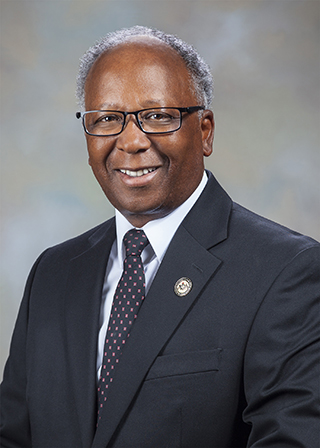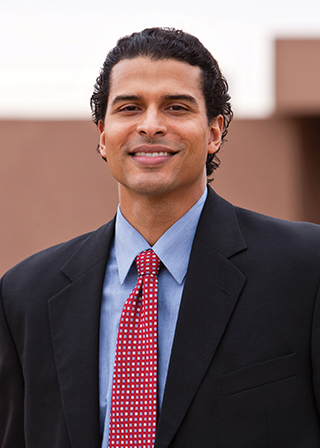Ken Holley wins BEYA Community Service award

Ken Holley didn’t set out to become a renowned Sandia recruiter and a deeply involved and committed leader in the community when he joined the Labs 30 years ago, but it sure worked out that way.
In recognition of the way things worked out — both in his work and in the community — Ken has been named a recipient of the 2016 Black Engineer of the Year (BEYA) award in Community Service.
“When I came to Sandia, I was simply looking for a job that would allow me to stay close to home and raise a family,” Ken says. “I didn’t have any particular vision as to what my career would look like.
“I started to think of my role at Sandia as something more than a job when I got a DOE assignment to run a startup program called the Science and Technology Alliance, whose purpose was to increase the number of minorities in engineering and technology.”
Ken worked with three universities — New Mexico Highlands, North Carolina A&T, and the University of Turabo in Puerto Rico — to recruit the most promising prospects to work at the Labs. Ken not only initiated the program, he created internships and an innovative mentorship program that was the first of its kind at the Labs.
Retention issues posed a special challenge
“The program’s success,” Ken says, “allowed me to create my vision around recruiting and around Sandia’s potential impact on engineering education and the diversity of the engineering workforce.”
Ken found out pretty quickly that recruiting top minority students was one thing; retaining those students as employees was another matter altogether.
“We recruited outstanding talent to Sandia, but we realized we were losing them too often,” he notes. In many cases, the student might represent the first member from his or her family to attend college, they were often far from home, and the desert Southwest was as different from their own hometowns as one could imagine. Then, too, in the case of young African Americans, they were coming to a community with a black population of just 3 percent.
Ken recognized the urgency of mentoring not just the engineer, the scientist, or the business professional, but the whole person. Ken took a personal, individual interest in each of his recruits. He introduced them to the community, to places to shop, to worship, to live. And his efforts paid off: Many of the students who went through the program are still at Sandia, some in management positions. Others went on to pursue advanced degrees as a result of their Sandia experience.
Ken wasn’t just focused on college recruits. He understood from the beginning that the door to opportunity must be opened much earlier than that. That’s why, in the more than 20 years since its inception, Ken has been dedicated to the HMTech program, which focuses on improving education outcomes for students in grades K-12 and inspires them to engage in STEM disciplines. He is also a very involved member of Alpha Phi Alpha, a fraternity encouraging academic excellence in youth, and many other education-focused organizations. He served on the board of directors for the Albuquerque Academy and is an active participant in various Christian ministries in the community.
Community, professional lives intersect
Ken sees community service as a holistic marriage of his personal and professional life.
“Community service was never a goal for me,” he says. ‘It was and remains a result of life activities. My goal and the goal of the organizations where I participate have a focus on giving back to the community, both locally and nationally. This local community work has been the foundation of national recruiting efforts with the universities where we recruit, especially for the Historically Black Colleges and Universities with their potential to produce excellent talent for Sandia.”
In a career marked by many successes, Ken says he wishes he had a chance to do a couple of things over again.
“I believe we are all guilty of this ‘would have, should have, could have’ syndrome in life,” he says. “Five minutes after any event, we know exactly what we should have said or done differently. It would have been nice to have a couple of mulligans — do overs — as they say in golf. I could have fought harder in all areas. Of course, there were people, really good people, we lost simply because of a lack of time or resources at that moment in time.”
Ken is retiring from the Labs this month after a storied career. And even without the mulligans, he looks back with pride over his role and Sandia’s role as a leader in its efforts to diversify the workforce.
“This lab has made great strides in diversity,” he says, noting that Sandia has NNSA’s first woman lab president, a woman as executive VP, and the first black woman VP of human resources.
“These are surprising and wonderful changes for our lab.
I marvel at our potential to make a difference while accomplishing our national security mission. I will miss being here but I know Sandia will continue to do great work through great people.”
Ken earned his BA at Winston Salem State University in North Carolina and an MBA at Oral Roberts University.
He and fellow Sandian Conrad James (see below), a recipient of a 2016 BEYA Special Recognition award, will be honored at the annual BEYA STEM conference in Philadelphia Feb. 18-20.
Conrad James wins BEYA Special Recognition award

Due to his varied accomplishments and extraordinary range of interests, Conrad James will receive the 2016 Black Engineer of the Year (BEYA) Special Recognition award at the annual BEYA STEM conference in Philadelphia, Feb. 18-20.
Conrad’s research interests include electrokinetic phenomena, neural engineering, and biomedical microfluidic devices. He holds six patents, has published 28 journal articles and book chapters, and now leads a Sandia Grand Challenge LDRD project to develop neural-inspired algorithms and computing hardware to automate and accelerate analysis of data-intensive problems.
He also has spent a considerable amount of time helping students improve their skill in science and engineering courses.
But there’s more.
In addition to his pedagogical and technical interests, Conrad is serving his second term as a member of New Mexico legislature, and also served on the Board of Regents at the University of New Mexico from 2013 to 2014.
Says Center 1700 Director Dave Sandison, “On rare occasions, an accomplished scientist will apply their leadership and problem-solving skills in other arenas, and Conrad is such a rare individual.”
A different way of addressing public policy
Conrad, asked why the father of three is willing to diversify his time so greatly, replies, “I feel engineers and scientists need to be more involved in policy-making, especially in areas outside of traditional topics that we often weigh in on, such as climate change. We have an interesting way of solving problems that is very different from people with other professional backgrounds.”
A National Merit semifinalist and valedictorian of his Columbus, Ohio, high school class, Conrad’s first publication originated from a high school internship at a hospital for children in which he assembled data to help guide the proper treatment for hemophiliac children with head trauma.
“The aim of that work was to improve the outcomes for injured patients and to develop metrics by which to guide the hospital staff,” he says.
He graduated summa cum laude from the University of Notre Dame with a bachelor’s degree in electrical engineering. While an undergraduate, he spent three summers as an intern at Abbott Laboratories in quality assurance, electrical engineering, and computer-aided design.
Later, he received his master’s and doctorate in applied and engineering physics from Cornell. While a graduate student, he helped developed patterning techniques for constructing networks of living neurons, with applications to eventually restore lost functionality in patients with damaged neural tissue. He also published several articles on using microelectrode array devices to characterize electrically active cells such as neurons and chromaffin cells, Sandia Div. 1000 VP Rob Leland wrote in his letter supporting Conrad’s BEYA application.
Conrad was hired in 2002 as a senior member of Sandia’s technical staff by Dave, who first met Conrad when recruiting at Cornell University in November 2001. “He stood out as a very bright scientist who considered the broader impact and context of his work. I believed Conrad’s abilities and interests would strengthen our application of microfluidics, and his many national and international presentations have done just that,” Dave says.
At Sandia, Conrad became interested in electrokinetic phenomena in microfluidic systems, and published papers on electric field-mediated separation and concentration of particles for biological detection applications. He also developed platforms for studying immune response in individual host cells, using microfluidic systems coupled with impedance monitoring and fluorescent markers. This technology focuses on single-cell response dynamics rather than bulk population studies where cell responses are averaged out and details are lost.
Most recently, Conrad is using his background in neural engineering to investigate designing and fabricating microelectronic devices for brain-inspired computing applications.
Says senior manager Wahid Hermina, “Conrad’s combination of expertise in microscience and bioscience, and his ability to work well in teams and lead them, has made him an ideal choice to lead a multimillion dollar grand challenge research project focused on development of a neural-inspired computer.”
Then there is Conrad’s outreach to students. As an undergraduate at Notre Dame, he tutored freshmen and sophomore engineering students in calculus. As a graduate student, he participated in the Saturday Science and Math Academy, a community program designed to promote math, science, and technology to minority students in elementary and junior high school. For that effort, he helped devise physics demonstrations as well as robotics and computer programming tutorials. After moving to Albuquerque, he volunteered for the Sandia-sponsored Hands-on Minds-on Technology program for junior high and high school students where he assisted with courses in standardized test preparation, robotics, and math puzzles.
Says manager Steve Casalnuovo, “Conrad’s BEYA Special Recognition Award confirms what his co-workers have always known: Conrad is a creative researcher with strong technical leadership abilities who is also dedicated to improving his community.”